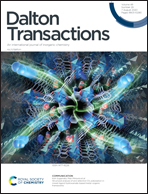Ligand-triplet migration in iridium(iii) cyclometalates featuring π-conjugated isocyanide ligands†
Abstract
The manipulation of the triplet excited state manifold leads to large differences in the photophysical properties within a given class of metal–organic chromophores. By the appropriate choice of ancillary ligand, large changes can be made both to the order and nature of the lowest excited states and therefore to the resulting photophysical properties. Herein, a series of four bis-2-phenylpyridine (ppy) cyclometalated Ir(III) compounds bearing two arylisocyanide ligands were synthesized and photophysically characterized to understand the effects of using ancillary ligands featuring systematic changes in π-conjugation. By varying the arylisocyanide ligands, the photoluminescence quantum yield ranged from 5% to 49% and the excited state lifetime ranged between 24 μs and 2 ms. These variations in photophysical response are consistent with lowering the triplet ligand-centered (3LC) state of the arylisocyanide ligand as the π system was extended, confirmed by 77 K photoluminescence emission spectra and ultrafast transient absorption experiments. The latter analysis gleaned detailed insight into the importance of the interplay of the 3LC state of the phenylpyridine and arylisocyanide ligands in these polychromophic Ir(III) molecules.



 Please wait while we load your content...
Please wait while we load your content...